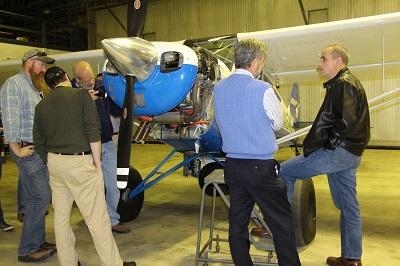Wed, Nov 26, 2014
While Everyone Is Talking About Electric Airplanes, Let’s Not Forget The Research Going On For A Dual Fuel Engine Using Gasoline And CNG
Earlier this month, Lycoming Engines hosted Stu Horn, President of Aviat Aircraft Inc., who flew the company’s Aviat Husky CNG to Williamsport, PA. This innovative aircraft is powered by a Lycoming IO-360-A1D6, which has been modified to be the world’s first dual-fuel compressed natural gas (CNG) aircraft, and can be powered by CNG or 100LL aviation gasoline with the flip of a switch.

The Aviat Husky CNG showcases how proven technology from CNG powered ground vehicles can be innovatively packaged into an aviation application to create a dual-fuel CNG/100LL aviation gasoline powered aircraft. “Aviat has shown with this demonstrator that the standard Lycoming IO-360-A1D6 can be powered by these fuels with some straightforward modifications to the engine fuel system,” stated Mike Kraft, Senior Vice President and General Manager of Lycoming Engines. Aviat and Lycoming have collaborated for many years on aircraft and engine technology, and their collaboration efforts toward advancements in aviation technology continue with this specialized application by Aviat.
The dual fuel Husky made its first public appearance at EAA AirVenture 2013 where it was displayed outside the innovations Pavilion. The Aviat project to power the Husky with CNG worked in consort with the Aviation Foundation of America. On the Aviat website, Greg Herrick, president of the Aviation Foundation of America said, “I’m impressed with how Aviat readily agreed to tackle this project, working with a team of engineers and craftsmen within the aviation and natural gas industries. The result is a sophisticated solution which can be readily applied to a variety of piston powered aircraft.”
Herrick continued, “One aspect we’re particularly excited about is the opportunity to dramatically reduce the cost of learning to fly. If a flight school installs a simple CNG refueling station they can cut the cost for the student’s fuel, perhaps by thousands of dollars, and the fuel is available wherever there is a natural gas line.”
It’s interesting to note that developers of electric powered aircraft are also aiming at the training market, and claiming the advantage of lower operating costs. It will be interesting to see how both of these developing technologies fit into the picture of aviation training.
(Image provided by Lycoming Engines of Lycoming employees checking out the CNG engine )
More News
From 2023 (YouTube Edition): "Ain’t Your Daddy’s Super Cub”—Don Wade Co-owned by Don and Ron Wade—the former of Don’s Dream Machines, a storied >[...]
Pilot-Rated Passenger Reported That The Pilot Did Not Adequately “Round Out” The Landing Flare And The Airplane Bounced And Yawed To The Right Analysis: The pilot state>[...]
Dead Reckoning Dead reckoning, as applied to flying, is the navigation of an airplane solely by means of computations based on airspeed, course, heading, wind direction, and speed,>[...]
Aero Linx: Lake Amphibian Club This website is created and sponsored by the Lake Amphibian Club, to help spread the word about these wonderful, versatile amphibians that can land j>[...]
“I am deeply honored to be sworn in as NASA administrator. NASA’s mission is as imperative and urgent as ever — to push the boundaries of human exploration, ignit>[...]
 Classic Aero-TV: In Praise of Alabamas Patriot Aircraft USA
Classic Aero-TV: In Praise of Alabamas Patriot Aircraft USA NTSB Final Report: Cirrus Design Corp SR22
NTSB Final Report: Cirrus Design Corp SR22 ANN's Daily Aero-Term (12.21.25): Dead Reckoning
ANN's Daily Aero-Term (12.21.25): Dead Reckoning ANN's Daily Aero-Linx (12.21.25)
ANN's Daily Aero-Linx (12.21.25) Aero-News: Quote of the Day (12.21.25)
Aero-News: Quote of the Day (12.21.25)



